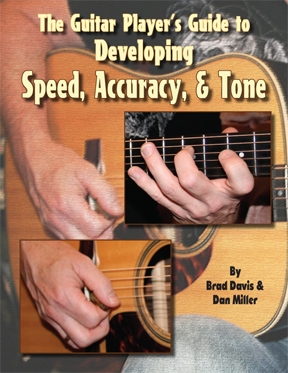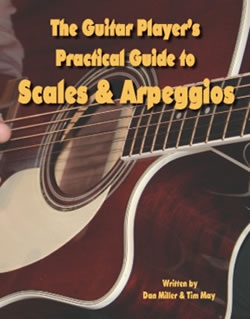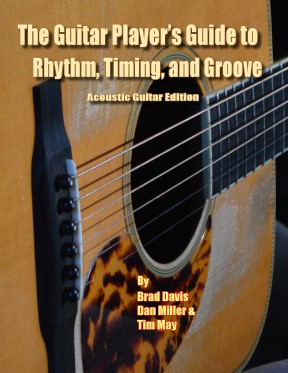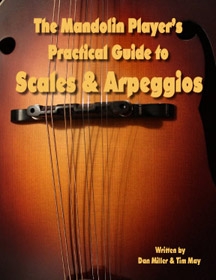Guitar Player's Guides
 Whether you are a new player or someone who has been playing for years, but has hit a wall, the Player's Guide series will help you take your playing to the next level. Utilizing text, tabs and audio, you will learn from the ground up – from fundamentals to highly complex techniques. The series not only teaches you how to play, but also how to
learn so that new concepts and skills come quickly and efficiently. This method will give you a solid foundation on which to build so that you can play any tune in any style without memorization and without copying other
players. Whether you are a new player or someone who has been playing for years, but has hit a wall, the Player's Guide series will help you take your playing to the next level. Utilizing text, tabs and audio, you will learn from the ground up – from fundamentals to highly complex techniques. The series not only teaches you how to play, but also how to
learn so that new concepts and skills come quickly and efficiently. This method will give you a solid foundation on which to build so that you can play any tune in any style without memorization and without copying other
players.
The Guitar Player's Guide and Mandolin Player's Guide series were developed by Dan Miller, Tim May and Brad Davis. Dan Miller, Editor of Flatpicking Guitar Magazine and author of many training books, founded the series after hearing from guitar players who were frustrated with the lack of progress in their playing. Many of them simply hit a wall that the could not break through. These players had tried one-on-one lessons, books and videos, but were still not able to play at the level they desired. Playing was no longer fun and many actually gave up altogether. Dan then interviewed over 300 players in order to better understand why they had hit dead ends. The answer was simple. Most of these players had not learned the fundamentals, or what Dan likes to call "the meat and potatoes" of playing. Without this foundation, it is difficult for a player to truly progress; to become the type of player who can play any song by ear, quickly pick up a new technique or jump into a jam session seamlessly.
With the help of professional players, Brad Davis and Tim May, Dan has launched this new series with two Player's Guides for guitar and one for Mandolin. They have also published Learning Music by Ear for All String Instruments which is a great supplement to this series. Over the next several months, they will be adding more volumes to the guitar and mandolin series.

|
|
The Guitar
Player's Guide to Developing Speed, Accuracy, and Tone
(by Brad Davis
and Dan Miller) is a 150 page book, with 157 audio tracks, that will
show you how to develop speed, accuracy, volume, tone, note clarity, and
fluidity for the acoustic guitar. Most books teach you the notes to
songs, this book teaches you how to make each note that you play in
those songs sound clear and distinct with rich tone and how you can
bring all of those notes together in a smooth and fluid flow at any
tempo.
The first section of this book explores all of the details
of right and left hand mechanics and technique and helps you analyze
your mechanics so that you can play the guitar in the most efficient and
effective manner. Then this book presents an extensive series of
step-by-step exercises to help you develop all of the "meat and
potatoes" pick style guitar techniques, to include: rhythm strums, down
stokes, alternate picking, rhythm pick pattern (RPP), picking against
the grain, forward and reverse roll crosspicking, forward-reverse
crosspicking, harmonized scales, string skipping techniques, floating,
playing drone strings, skip string crosspicking, rest strokes, sweep
picking, and double-down-up picking. The material is presented in a
series of six "phases," each building on the techniques and exercises
that are presented in earlier phases. The step-by-step approach will
insure that your pick style acoustic guitar technique is fully
developed. If you are looking to improve your speed, accuracy, tone,
volume, note clarity, and fluidity, this is the book for you. Players at
all levels can benefit greatly from the material presented in this
book.
Read more...
|
|
|
|
Book and CD $29.95
|
|
|
|
|
|
|
|
|
|
|
|
|
|
|
|

|
|
The Guitar Player's Practical Guide to Scales and
Arpeggios
form the foundation of all song melodies, arranged solos,
licks, phrases, and improvisations on the guitar. If you are familiar
with scales and arpeggios, and know how to use them, your ability to
arrange and improvise your own solos will be greatly enhanced. Scale
knowledge is the road map that can take you anywhere you want to go in
music. This new 160 page book (with 136 audio tracks on 2 CDs) by
Dan Miller and Tim May not only teaches you how to learn scales in a
way that is easy, fun, interesting, and informative, it also shows you
how to practically apply scales when learning new melodies, embellishing
those melodies to create your own solos and variations, and in
exploring improvisations.
Most books that present scales and
arpeggios will display scale patterns all up and down the neck and
address many keys and many different scales (major, minor, pentatonic,
diminished, whole tone, bebop, etc). This approach tends to provide too
much theory and not enough practical information about how these scales
can be put to practical use right away.
"The Guitar Player's
Practical Guide to Scale and Arpeggios" focuses on the open position
(first five frets) and the G major, G major pentatonic, G major blues, G
minor pentatonic, and G minor blues scales. The goal here was to really
dive in and explore the most useful scales for playing American roots
music in the most common key and the most common position. By using this
approach the authors not only have allowed themselves time and space
for a very thorough examination of these scales through many, many
exercises and examples, but they additionally provide a clear cut method
for exploring and applying the same examples in a variety of keys and
scales types.
Read more...
|
|
|
|
Book and CD $29.95
|
|
|
|
|
|
|
|
|
|
|
|
|
|
|
|
|
|
|
|
|

|
|
The Guitar Player's Guide to Rhythm, Timing, and Groove - 240 page book with 3
Audio CDs (over 200 audio tracks!)
This book presents material that will help you provide strong acoustic guitar accompaniment in any musical
situation by teaching you how to:
1) Keep better time and learn to develop and maintain a solid groove.
2) Outline and define the chords and chord changes in ways that provide texture and interest.
3) With the use of bass runs and passing chords, lead the listener’s ear through the chord progression in a way that helps provide forward movement and momentum to the music.
4) Provide texture, dynamics, and interest to the rhythm accompaniment in ways that positively and tastefully support the vocalist and lead instrumentalists and improve the overall band sound by using fill licks, bass runs, passing chords, chord substitutions, chord extensions, and chord inversions.
Part of the problem that acoustic guitar players who have the desire to learn how to be better rhythm players have encountered is the lack of a good, solid, step-by-step learning method that will allow their rhythm skill and knowledge to continually develop.
Read more...
|
|
|
|
Book and CD $29.95
|
|
|
|
|
|
|
|
|
|
|
|
|
|
|
|
|
|
|
|
|

|
|
The Mandolin Player's Practical Guide to Scales and
Arpeggios
form the foundation of all song melodies, arranged solos,
licks, phrases, and improvisations on the guitar. If you are familiar
with scales and arpeggios, and know how to use them, your ability to
arrange and improvise your own solos will be greatly enhanced. Scale
knowledge is the road map that can take you anywhere you want to go in
music.
This new 148 page book (with 136 audio tracks on 2 CDs) by
Dan Miller and Tim May not only teaches you how to learn scales in a
way that is easy, fun, interesting, and informative, it also shows you
how to practically apply scales when learning new melodies, embellishing
those melodies to create your own solos and variations, and in
exploring improvisations.
Most books that present scales and
arpeggios will display scale patterns all up and down the neck and
address many keys and many different scales (major, minor, pentatonic,
diminished, whole tone, bebop, etc). This approach tends to provide too
much theory and not enough practical information about how these scales
can be put to practical use right away.
"The Mandolin
Player's Practical Guide to Scale and Arpeggios" focuses on the open
position (first seven frets) and the G major, G major pentatonic, G
major blues, G minor pentatonic, and G minor blues scales. The goal here
was to really dive in and explore the most useful scales for playing
American roots music in the most common key and the most common
position.
Read more...
|
|
|
|
Book and CD $29.95
|
|
|
|
|
|
|
|
|
|
|
|







